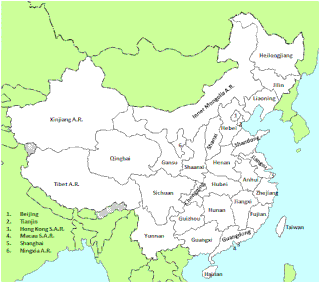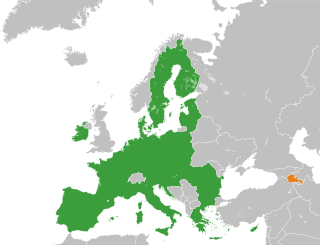A European Union Association Agreement or simply Association Agreement (AA) is a treaty between the European Union (EU), its Member States and a non-EU country that creates a framework for co-operation between them. Areas frequently covered by such agreements include the development of political, trade, social, cultural and security links.

The United States–Korea Free Trade Agreement, also known as KORUS FTA, is a trade agreement between the United States and South Korea. Negotiations were announced on February 2, 2006, and concluded on April 1, 2007. The treaty was first signed on June 30, 2007, with a renegotiated version signed in early December 2010.

India–South Korea relations are the bilateral relations between India and South Korea. Formal establishment of diplomatic ties between the two countries occurred in 1973. Since then, several trade agreements have been reached: Agreement on Trade Promotion and Economic and Technological Co-operation in 1974; Agreement on Co-operation in Science & Technology in 1976; Convention on Double Taxation Avoidance in 1985; and Bilateral Investment Promotion/Protection Agreement in 1996.

New Zealand is party to several free trade agreements (FTAs) worldwide.

India-Singapore relations, also known as Indian-Singaporean relations or Indo-Singaporeanrelations, are the bilateral relations between India and Singapore. Relations between the two countries have traditionally been strong and friendly, with the two nations enjoying extensive cultural and commercial relations. India and Singapore have signed the Comprehensive Economic Cooperation Agreement (CECA) and strategic-relationship agreement in order to increase trade, investments and economic cooperation, and expanded bilateral cooperation on maritime security, training forces, joint naval exercises, developing military technology and fighting terrorism.

The Economic Cooperation Framework Agreement (ECFA) is a free trade agreement (FTA) between the governments of the People's Republic of China and the Republic of China, that aims to reduce tariffs and commercial barriers between the two sides, as well as improve cross-strait relations.
The Comprehensive Economic Partnership for East Asia (CEPEA) is a Japanese led proposal for trade co-operation, free trade agreement, among the 16 present member countries of the East Asia Summit. All those movements and efforts were taken over by the following Regional Comprehensive Economic Partnership.
The ASEAN–India Free Trade Area (AIFTA) is a free trade area among the ten member states of the Association of Southeast Asian Nations (ASEAN) and the Republic of India. The initial framework agreement was signed on 8 October 2003 in Bali, Indonesia. and the final agreement was on 13 August 2009. The free trade area came into effect on 1 January 2010. India hosted the latest ASEAN-India Commemorative Summit in New Delhi on 26 January 2018. In the financial year 2017–18, Indo-ASEAN bilateral trade grew by almost 14% to reach US$81.3 billion. India's imports from ASEAN were valued at US$47.13 billion while its exports to ASEAN stood at US$34.2 billion.
The China–South Korea Free Trade Agreement is a free trade agreement between China and South Korea signed in 2014 and active since the following year.

Indonesia and South Korea established diplomatic relations in 1973. Both countries share a common vision, values and the will to contribute to the international community as middle powers. Both countries are members of G-20 and APEC. South Korea has an embassy in Jakarta and Indonesia has an embassy in Seoul. According to a 2014 BBC World Service Poll, 48% of Indonesians view South Korea's influence positively, with 27% expressing a negative view. The Chinese Indonesian merchant Chen Yanxiang visited Korea between the 1390s and the 1410s, the first major contact between the two nations.

The Regional Comprehensive Economic Partnership is a free trade agreement among the Asia-Pacific countries of Australia, Brunei, Cambodia, China, Indonesia, Japan, South Korea, Laos, Malaysia, Myanmar, New Zealand, the Philippines, Singapore, Thailand, and Vietnam. The 15 member countries account for about 30% of the world's population and 30% of global GDP, making it the largest trade bloc in history. Signed in November 2020, RCEP is the first free trade agreement among the largest economies in Asia, including China, Indonesia, Japan, and South Korea.
The European Union and Indonesia have built robust commercial relations, with bilateral trade amounting to approximately €25 billion in 2012 resulting in a sizeable €5.7 billion trade surplus for Indonesia with the EU. As of 2012 EU and Indonesia has been marked by an upward trend. Whereas total trade was worth almost €16 billion in 2009, by 2011 it had already reached €23.5 billion.
The Hong Kong – New Zealand Closer Economic Partnership Agreement is a bilateral free trade agreement signed between the Hong Kong Special Administrative Region of China and New Zealand in March 2010. It is the first bilateral free trade agreement on goods and services that Hong Kong SAR has signed with a foreign country. Hong Kong-New Zealand CEPA complements New Zealand's Free Trade Agreement (FTA) with China two years before, and enhances the potential for Hong Kong to be used as a platform for trade into the Mainland China. Hong Kong is a Special Administrative Region of China but has autonomy in matters of trade.

The Deep and Comprehensive Free Trade Areas (DCFTA) are three free trade areas established between the European Union, and Georgia, Moldova, and Ukraine respectively. The DCFTAs are part of each country's EU Association Agreement. They allow Georgia, Moldova, and Ukraine access to the European Single Market in selected sectors and grant EU investors in those sectors the same regulatory environment in the associated country as in the EU. The agreements with Moldova and Georgia have been ratified and officially entered into force in July 2016, although parts of them were already provisionally applied. The agreement with Ukraine was provisionally applied since 1 January 2016 and formally entered into force on 1 September 2017.

The most significant initiative made by the Narendra Modi government is the focus on neighbouring countries and major Asian powers coupled with emphasizing on the two decades old Look East policy. Asia being the major focus area of his foreign policy, Modi and his foreign minister chose several Asian countries for their initial bilateral visits. He has made state visits to Bhutan and Nepal and Japan within the first 100 days of his government and also hosted Asian leaders like former Prime Minister Tony Abbott of Australia, President Xi Jinping of China and Prime Minister Nguyễn Tấn Dũng of Vietnam, apart from inviting SAARC leaders in his inauguration ceremony. External Affairs Minister Sushma Swaraj has also made official visits to several Asian capitals like Dhaka, Bangladesh, Kathmandu, Nepal, Naypidaw, Myanmar, Singapore, Hanoi, Vietnam, Manama, Bahrain, Kabul, Afghanistan, Dushanbe, Tajikistan, Malé, Maldives, Abu Dhabi, United Arab Emirates, Seoul, South Korea and Beijing China.

The Indonesia–Australia Comprehensive Economic Partnership Agreement is a bilateral agreement signed between Australia and Indonesia in March 2019, ratified by Australia in November 2019 and Indonesia in February 2020. The agreement contains a free trade agreement removing tariffs from nearly all products traded between both countries, in addition to loosening investment regulations in Indonesia for Australian firms and increasing the quota for Indonesians seeking vocational training in Australia.

The Armenia–EU Comprehensive and Enhanced Partnership Agreement or CEPA is a partnership agreement between the European Union and Armenia. The agreement advances the bilateral relations between the European Union and Armenia to a new, partnership level and regulates cooperation in political and economic sectors, while enhancing trade relations. The agreement develops these areas further, providing a long-term basis for integrating and strengthening EU–Armenia relations. The agreement is also designed to bring Armenian laws and regulations gradually closer to the EU acquis.
India is party to free trade agreements (FTAs) and other trade agreements with many countries and trade blocs, and is negotiating with many others. As of 2022, India has preferential access, economic cooperation and FTA with more than 50 individual countries.
The Indonesia–Korea Comprehensive Economic Partnership Agreement is a bilateral agreement signed between Indonesia and South Korea. Negotiated since 2012, it was signed in December 2020 and came into effect on 1 January 2023. The agreement eliminated trade tariffs on most goods traded between the two countries, in addition to covering investment, human resource development, and technology transfers.












